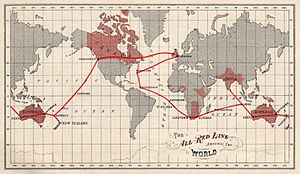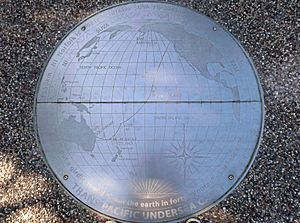Pacific Cable Station facts for kids
The Pacific Cable Station was built in 1902 in Southport, a town on Australia's Gold Coast in Queensland. This important station helped send messages across the world for 60 years, closing in 1962. Most of the original buildings are gone now. However, the small Southport Cable Hut still stands. It is listed on the Queensland Heritage Register as a special historical site.
Contents
Connecting Australia: Early Telegraphs
Imagine a time before phones or the internet! In the mid-1800s, a new way to send messages quickly over long distances appeared: the telegraph. This amazing invention used electricity to send coded messages. It was like sending a text message, but much slower and through wires!
The telegraph changed society a lot. News services like Associated Press and Reuters started using it to get news fast. You could even send money orders using the telegraph.
In Australia, the telegraph helped connect the different colonies. By 1860, New South Wales, Victoria, and South Australia were linked. Queensland got its first telegraph connection in 1861, linking Brisbane and Ipswich. Soon after, Brisbane was connected to Sydney.
The first telegraph link between Australia and Britain opened in 1872. This cable went through places like Singapore, India, and Gibraltar. It was very expensive to send messages this way. Most people could not afford to use it.
Planning the Pacific Cable Project
A man named Sandford Fleming from Canada had a big idea. He wanted a new cable route between Australia and Great Britain. This new route would go through Canada and across the Pacific Ocean. He thought this "Pacific Cable" would be safer during wars because it would only pass through countries that were part of the British Empire. These countries were often coloured red on old maps, so the route became known as the "All Red Line."
Another big reason for a new cable was to lower the high cost of sending messages. The old cable company had a monopoly, meaning they were the only ones. The new Pacific Cable would create competition and make messages much cheaper. When it opened, the cost of telegrams dropped by more than half! It also allowed direct communication with the United States, opening up new trade opportunities.
The plan was for the Pacific Cable to only pass through British areas. In 1896, the Pacific Cable Board was formed. It had representatives from Britain, Canada, and Australia. This board was in charge of building and running the cable. A survey of the ocean floor for the cable route began in 1899.
In 1901, a site for the cable station in Australia was chosen in Southport. It was a good spot for the cable to come ashore. The government asked for bids to build the station buildings. In 1902, a builder named E. Boyle won the contract. By the end of 1902, the main building was almost ready. The Southport Cable Station officially opened on 4 November 1902.
Laying the Pacific Cable
The chosen route for the cable connected Southport (Australia), Norfolk Island, Fiji, Fanning Island, and Vancouver Island (Canada). A branch cable also connected to New Zealand. This was the famous "All Red Line."
Cable laying began in 1902 with two ships, the Anglia and the Colonia. The Colonia, a ship built just for this project, laid the cable from Vancouver Island to Fanning Island in the middle of the Pacific. The Anglia laid the cable from Southport to Norfolk Island, Fiji, New Zealand, and Fanning Island.
The cable landed at Main Beach in Southport in March 1902. It then went under the Nerang River to the main station buildings. The Pacific Cable was finished on 31 October 1902. It was officially opened in Southport on 3 November 1902. The total cost was about 2 million pounds.
The cable was buried in a trench through the sand dunes near Southport. It ended at a small building called a cable hut, right near the beach. From this hut, another cable went under the Nerang River to the main cable station.
How the Cable Was Used
The first message was sent on 31 October 1902. The cable opened for public use on 8 December 1902. Until 1912, Southport handled telegraph messages for all of Australia.
There was only one major problem with the service during World War I. In 1914, a German warship, the Nurnberg, cut the cable at Fanning Island.
Over time, technology improved. In 1923, new equipment made Southport a "repeater station." This meant it helped boost the signal along the cable. The Pacific Cable Board ran the station until 1932. After that, another company called Cable & Wireless took over.
During World War II, the cable was very important. It was Australia's main link to the United Kingdom. After the attack on Pearl Harbor in 1941, Australian authorities worried about the cable being cut. They even closed schools in the Southport area for a while. Luckily, the area was later considered safe.
In 1946, the Australian Government took over responsibility for the cable.
In October 1962, a new, more modern cable system called COMPAC was completed. This new cable connected Sydney and Vancouver. Because of this, the original Pacific Cable was no longer needed. The Southport to Norfolk Island cable was closed. The main Cable Station building in Southport was sold to the De La Salle Brothers. They used it as a youth centre.
The Southport Cable Hut
Quick facts for kids Southport Cable Hut |
|
|---|---|

The Cable Hut in 2015
|
|
| Location | Cable Park, Main Beach Parade, Main Beach, Gold Coast City, Queensland, Australia |
| Official name: Southport Cable Hut (former) | |
| Type | state heritage (built) |
| Designated | 3 May 2007 |
| Reference no. | 602611 |
| Significant period | 1950s |
| Lua error in Module:Location_map at line 420: attempt to index field 'wikibase' (a nil value). | |
The Southport Cable Hut is a special historical building located at Cable Park in Main Beach. This small brick hut was the Australian end of the Pacific Cable. The first cable hut, built in 1902, was destroyed in a big storm around 1950. The current brick hut was built in 1951 to replace it.
What the Cable Hut Looks Like
Cable Park is a small grassy area in Main Beach. The Cable Hut is a small brick building in the park, set back from the road.
The hut is about 2.4 metres square and 2.7 metres tall. It has no windows, but small vents let air in. The roof is flat and made of concrete. A simple wooden door is in the front.
Inside, the hut has a wooden floor. Cables come up through the floor and run along the back wall. These are the ends of the Pacific Cable itself. There are also cables that connected to Sydney and to the main Cable Station. You can still see a pressure gauge and other old equipment inside the hut. This equipment helped keep gas pressure in the cable that went to the main station.
Outside the hut, a paved path leads to a round platform. On this platform is a metal plaque with a map of the world. It shows the route of the Pacific Cable.
What Happened to the Buildings?
In the early 1980s, the De La Salle Brothers decided to change the area. The main Cable Station buildings were moved. Two of these buildings were taken to The Southport School. They are now used as music rooms.
The school and the cable station had a long history together. Staff from the cable station helped train students and even encouraged sports games with the school. The school even named a mathematics prize after a cable station supervisor. The buildings were carefully taken apart into 12 sections and moved. They were put back together at The Southport School and reopened in 1982. These buildings are now listed on the Gold Coast Local Heritage Register.
![]() This Wikipedia article was originally based on "The Queensland heritage register" published by the State of Queensland under CC-BY 3.0 AU licence (accessed on 7 July 2014, archived on 8 October 2014). The geo-coordinates were originally computed from the "Queensland heritage register boundaries" published by the State of Queensland under CC-BY 3.0 AU licence (accessed on 5 September 2014, archived on 15 October 2014).
This Wikipedia article was originally based on "The Queensland heritage register" published by the State of Queensland under CC-BY 3.0 AU licence (accessed on 7 July 2014, archived on 8 October 2014). The geo-coordinates were originally computed from the "Queensland heritage register boundaries" published by the State of Queensland under CC-BY 3.0 AU licence (accessed on 5 September 2014, archived on 15 October 2014).



